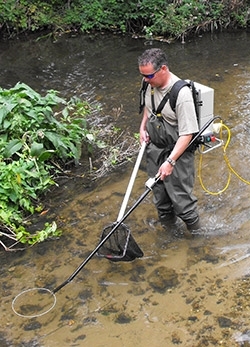 At its most basic, electro-fishing can be described as the application of an electric field into water in order to incapacitate fish; thus rendering them easier to catch. The concept was devised and patented in the middle 19th Century (Isham Baggs 1863). However, there is still debate about the underlying causes and mechanisms responsible for the fish response.
At its most basic, electro-fishing can be described as the application of an electric field into water in order to incapacitate fish; thus rendering them easier to catch. The concept was devised and patented in the middle 19th Century (Isham Baggs 1863). However, there is still debate about the underlying causes and mechanisms responsible for the fish response.
The technique has many advantages over other methods available to fishery workers for capturing fish and is widely used. Its great advantage is that preliminary preparation of the site is not required, as it is where netting is to take place and the number of operators required is low - two people are required as a minimum for safety reasons.
The main disadvantage of the method is its potential to cause injury (both physical and physiological) and, in extreme circumstances, death to the fish. This disadvantage can, however, be reduced to negligible levels by the choice of appropriate method, suitable training for personnel and the experienced use of the apparatus.
Whilst it is possible to capture fish without knowing how the technique works, knowledge of the fundamentals will enhance catch efficiency and help reduce some of the drawbacks concerning injury mentioned above. Knowledge of the basic electrical principles will also allow equipment to be calibrated to produce similar fish capture probabilities and thus improve standardisation between sampling.
In order to assist in determining the power requirement and expected voltage field size in electro-fishing, an Excel spreadsheet has been prepared and can be downloaded.
For more information, contact wbeaumont@gwct.org.uk.
Get the Latest News & Advice
Join over 100,000 subscribers and stay updated on our latest advice, research, news and offers.
*You may change your mind any time. For more information, see our Privacy Policy.